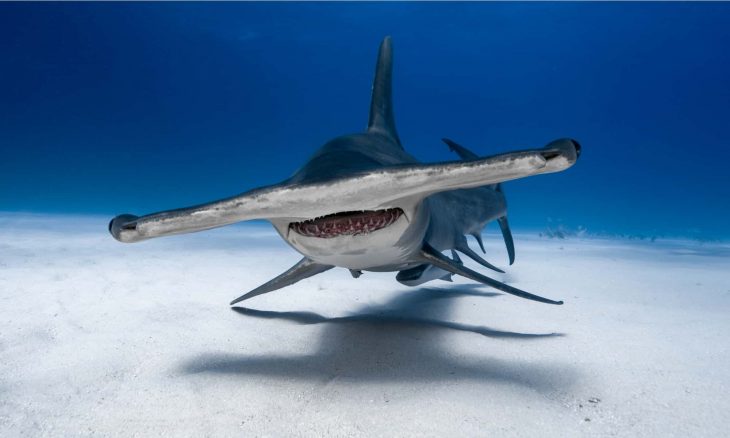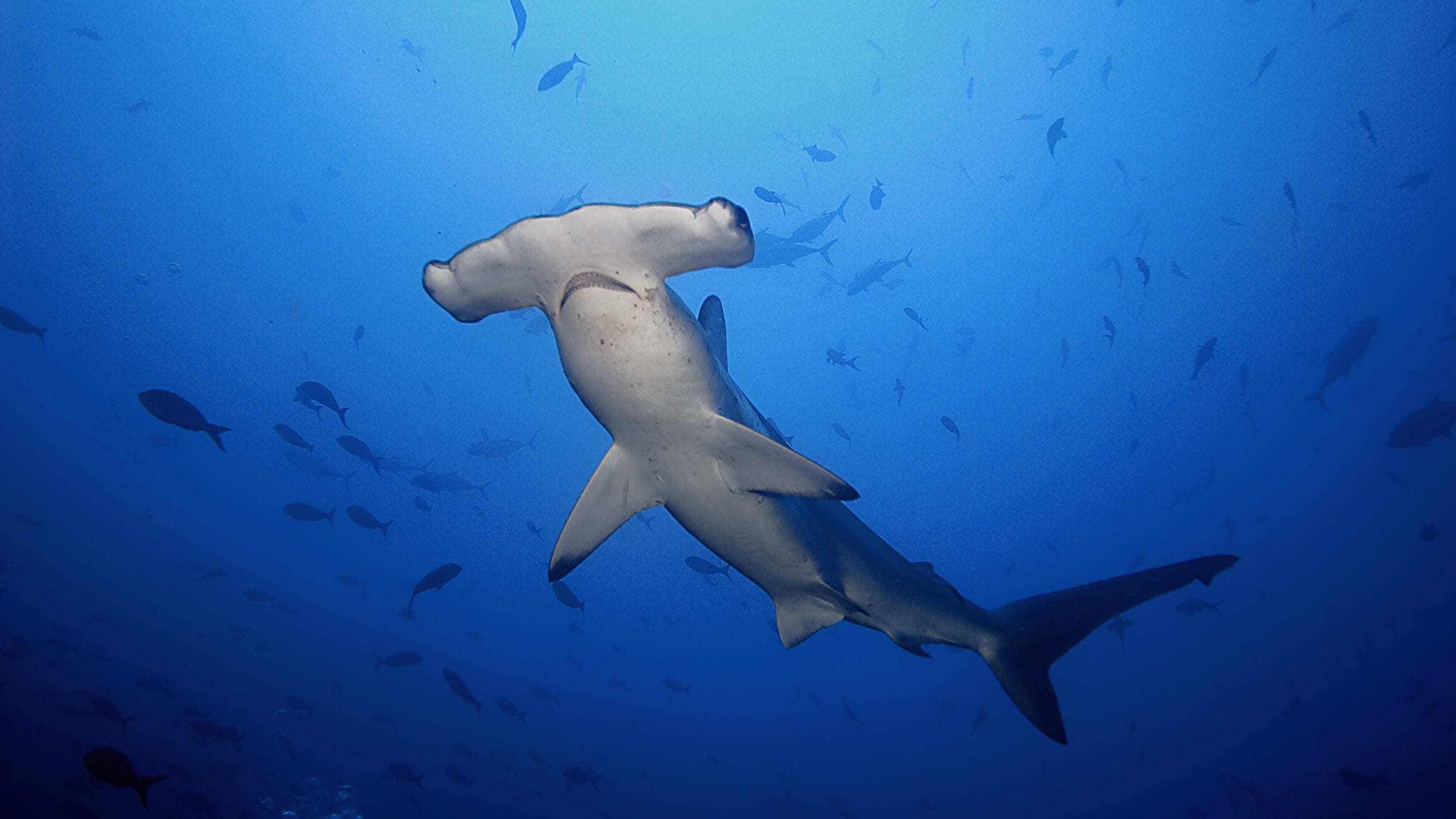
Hammerhead sharks are fascinating creatures that captivate the imagination of both children and adults. With their unique hammer-shaped heads and impressive size, they are among the most distinctive and iconic species in the ocean. In this article, we will explore 20 hammerhead shark facts that will amaze and educate young minds about these incredible marine animals.
Hammerhead Shark Appearance
Hammerhead sharks have distinctively shaped head that resembles a hammer. This unique feature, called a cephalofoil, is wide and flattened, with eyes positioned at each end. The shape of their head allows for excellent 360-degree vision, enabling them to spot prey and potential threats with ease.
Hammerhead Shark Size
Hammerhead sharks can grow to impressive sizes. The largest species, the great hammerhead, can reach lengths of up to 20 feet (6 meters). Other species, such as the smooth hammerhead and scalloped hammerhead, are typically smaller, ranging between 6 to 14 feet (1.8 to 4.3 meters) in length.
Its Diet
Hammerhead sharks are carnivorous predators. They have a diverse diet that includes a variety of marine animals such as fish, squid, octopus, and crustaceans. Their hammer-shaped head allows for a wider field of vision, which aids in locating and capturing their prey.
Hammerhead Shark Teeth
Hammerhead sharks have sharp and serrated teeth that are well-suited for capturing and consuming their prey. They use their teeth to tear and swallow their food whole, as they do not chew their meals.
Its Habitat
Hammerhead sharks inhabit both coastal and offshore waters in tropical and temperate regions around the world. They can be found in various habitats, including coral reefs, estuaries, and deep-sea environments. Some species, like the scalloped hammerhead, undertake long-distance migrations.
Its Behavior
Hammerhead sharks are known for their unique schooling behavior. They often gather in large groups, called schools or shoals, which can consist of hundreds or even thousands of individuals. This behavior helps protect them from predators and increases their chances of finding food.
Hammerhead Shark Adaptations
The hammerhead shark’s unique head shape provides several adaptations that aid in its survival. The wide span of their head improves their sensory abilities, allowing them to detect electrical fields and locate prey more efficiently. It also helps them maneuver and stabilize while swimming.
Hammerhead Shark Reproduction
Hammerhead sharks reproduce through internal fertilization. The males have claspers, which are modified pelvic fins used to transfer sperm to the female during mating. Females give birth to live young, and the gestation period can range from 6 to 12 months, depending on the species.

Hammerhead Shark Offspring
After birth, hammerhead shark pups are fully formed and ready to swim independently. The number of pups born in a single litter can vary depending on the species, with some producing as few as 6 pups, while others can give birth to over 50.
Its Lifespan
The lifespan of hammerhead sharks can vary among species, but on average, they live for around 20 to 30 years. Factors such as habitat, food availability, and predation can influence their lifespan.
Hammerhead Shark Conservation
Hammerhead sharks face various threats, including overfishing and habitat degradation. Some species, such as the scalloped hammerhead, are listed as endangered or critically endangered by conservation organizations. Efforts are being made worldwide to protect and conserve these remarkable creatures.
Hammerhead Shark Mythology and Folklore
Hammerhead sharks hold cultural significance in different societies. In some cultures, they are seen as symbols of strength, power, and protection. Folklore often portrays them as guardians of the sea or revered creatures with supernatural qualities.
Hammerhead Shark Communication
While hammerhead sharks do not have vocal cords, they communicate through body language and electrical signals. Their sensory organs, called ampullae of Lorenzini, can detect the electrical fields generated by other animals, aiding in communication and navigation.
Hammerhead Shark Speed and Swimming
Hammerhead sharks are efficient swimmers and can reach speeds of up to 25 miles per hour (40 kilometers per hour). Their streamlined bodies and powerful tails enable them to navigate the ocean with agility and grace.

Hammerhead Shark Species Diversity
There are currently nine recognized species of hammerhead sharks. These include the great hammerhead, scalloped hammerhead, smooth hammerhead, bonnethead, and more. Each species has its unique characteristics and adaptations.
Research and Study
Scientists and researchers conduct extensive studies on hammerhead sharks to better understand their behavior, ecology, and conservation needs. Their research contributes to the development of conservation strategies and the protection of these magnificent creatures.
Hammerhead Shark Predators
Despite their size and strength, hammerhead sharks have predators in the ocean. Larger sharks, such as the tiger shark and bull shark, may prey on smaller hammerhead sharks. Additionally, some species of killer whales and larger marine mammals can pose a threat to them.
Hammerhead Shark Sightings and Ecotourism
Hammerhead sharks are a popular attraction for scuba divers and snorkelers. Certain locations, such as the Galapagos Islands and the Cocos Island, are renowned for their hammerhead shark sightings. Responsible ecotourism practices ensure the protection of these animals and their habitats.
Its Contributions to Ecosystems
Hammerhead sharks play a vital role in marine ecosystems. As top predators, they help maintain the balance of marine populations by regulating the abundance of prey species. Their presence also indicates the overall health of the ecosystem.
Conclusion
Hammerhead sharks are magnificent creatures that inhabit the world’s oceans. Their unique appearance, fascinating behaviors, and important ecological role make them a subject of awe and admiration. By learning about these incredible animals, we gain a deeper appreciation for the diverse and wondrous life beneath the waves.
Frequently Asked Questions (FAQs)
Are hammerhead sharks dangerous to humans?
Hammerhead sharks are generally not considered dangerous to humans. They are not known to have a significant history of unprovoked attacks on humans. However, as with any wild animal, it’s important to exercise caution and respect their space when encountering them in their natural habitat.
Do all hammerhead shark species have the same head shape?
No, while all hammerhead sharks have a distinctive head shape, the specific shape and size of the cephalofoil can vary among different species. Some have more pronounced hammer-shaped heads, while others have more curved or rounded heads.
Where can you find hammerhead sharks in the wild?
Hammerhead sharks can be found in various regions around the world, including tropical and temperate waters. They are commonly sighted in locations such as the Galapagos Islands, Cocos Island, Maldives, Bahamas, and certain areas along the coasts of the United States and Australia.
How long do hammerhead sharks live in captivity?
Hammerhead sharks have been observed to live for extended periods in captivity, with some individuals reaching their 20s or even 30s. However, it’s important to note that keeping hammerhead sharks in captivity requires specialized facilities and care to ensure their well-being.
How can we help conserve hammerhead sharks?
There are several ways to contribute to the conservation of hammerhead sharks. Supporting organizations dedicated to marine conservation, promoting sustainable fishing practices, reducing single-use plastics, and advocating for the protection of their habitats are all important steps in safeguarding these magnificent creatures for future generations.
Was this page helpful?
Our commitment to delivering trustworthy and engaging content is at the heart of what we do. Each fact on our site is contributed by real users like you, bringing a wealth of diverse insights and information. To ensure the highest standards of accuracy and reliability, our dedicated editors meticulously review each submission. This process guarantees that the facts we share are not only fascinating but also credible. Trust in our commitment to quality and authenticity as you explore and learn with us.


